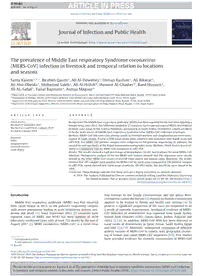
2018 The prevalence of Middle East respiratory Syndrome coronavirus (MERS-CoV) infection in livestock and temporal relat PDF
Preview 2018 The prevalence of Middle East respiratory Syndrome coronavirus (MERS-CoV) infection in livestock and temporal relat
Please cite this article in press as: Kasem S, et al. The prevalence of Middle East respiratory Syndrome coronavirus (MERS-CoV) infection in livestock and temporal relation to locations and seasons. J Infect Public Health (2018), https://doi.org/10.1016/j.jiph.2018.01.004 ARTICLE IN PRESS G Model JIPH-860; No.of Pages5 Journal of Infection and Public Health xxx (2018) xxx–xxx Contents lists available at ScienceDirect Journal of Infection and Public Health journal homepage: http://www.elsevier.com/locate/jiph The prevalence of Middle East respiratory Syndrome coronavirus (MERS-CoV) infection in livestock and temporal relation to locations and seasons Samy Kasem a,b,∗, Ibrahim Qasim c, Ali Al-Doweriej a, Osman Hashim c, Ali Alkarar c, Ali Abu-Obeida c, Mohamed Saleh a, Ali Al-Hofufi d, Hussein Al-Ghadier d, Raed Hussien a, Ali AL-Sahaf c, Faisal Bayoumi a, Asmaa Magouz b a Department of Veterinary Health and Monitoring, Ministry of Environment, Water and Agriculture,65 King Abdulaziz Road, Riyadh, 11195, Saudi Arabia b Department of Virology, Faculty of Veterinary Medicine, Kafrelsheikh University, Kafrelsheikh,El-Geish Street, 33516, Egypt c Department of Veterinary Services, Ministry of Environment, Water and Agriculture,65 King Abdulaziz Road, Riyadh, 11195, Saudi Arabia d Department of Veterinary Laboratory, Ministry of Environment, Water and Agriculture,65 King Abdulaziz Road, Riyadh, 11195, Saudi Arabia a r t i c l e i n f o Article history: Received 27 September 2017 Received in revised form 3 January 2018 Accepted 9 January 2018 Keywords: MERS Slaughterhouses Livestock markets Saudi Arabia a b s t r a c t Background: The Middle East respiratory syndrome (MERS) has been reported for the first time infecting a human being since 2012. The WHO was notified of 27 countries have reported cases of MERS, the majority of these cases occur in the Arabian Peninsula, particularly in Saudi Arabia. Dromedary camels are likely to be the main source of Middle East respiratory syndrome virus (MERS-CoV) infection in humans. Methods: MERS-CoV infection rates among camels in livestock markets and slaughterhouses were inves- tigated in Saudi Arabia. A total of 698 nasal swabs were collected and examined with Rapid assay and rtRT-PCR. Ten MERS-CoV positive samples were subjected to full genomic sequencing. In addition, the sensitivity and specificity of the Rapid immunochromatographic assay (BioNote, South Korea) was eval- uated as a diagnostic tool for MERS-CoV compared to rtRT-PCR. Results: The results showed a high percentage of dromedaries (56.4%) had evidence for nasal MERS-CoV infection. Phylogenetic analysis of the ten MERS-CoV isolates showed that the sequences were closely related to the other MERS-CoV strains recovered from camels and human cases. Moreover, the results showed that 195 samples were positive for MERS-CoV by rapid assay compared to 394 positive samples of rtRT-PCR, which showed low rapid assay sensitivity (49.49%) while, the specificity were found to be 100%. Conclusion: These findings indicate that these sites are a highly-hazardous to zoonotic diseases. © 2018 The Authors. Published by Elsevier Limited on behalf of King Saud Bin Abdulaziz University for Health Sciences. This is an open access article under the CC BY-NC-ND license (http:// creativecommons.org/licenses/by-nc-nd/4.0/). Introduction Middle East respiratory syndrome (MERS) was first reported from Saudi Arabia in 2012, in the patient’s respiratory samples with severe pneumonia leading to acute respiratory distress syn- drome and death [1]. Since September 2012, 27 countries have reported cases of MERS and WHO has been notified of 2079 laboratory-confirmed cases with at least 722 deaths by the end of August 2017 [2]. MERS coronavirus (MERS-CoV) is a novel virus ∗ Corresponding author. E-mail addresses:
